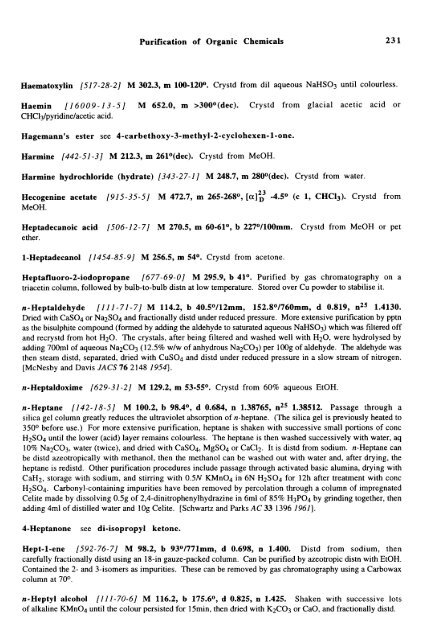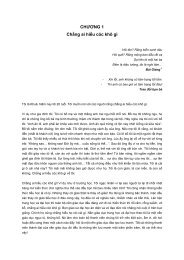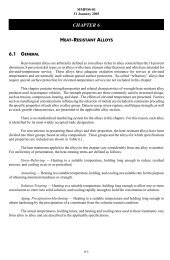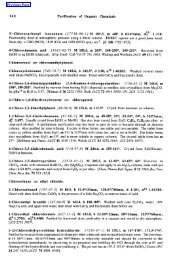You also want an ePaper? Increase the reach of your titles
YUMPU automatically turns print PDFs into web optimized ePapers that Google loves.
Purification of Organic Chemicals 23 1<br />
Haematoxylin 151 7-28-21 M 302.3, m 100-120°. Crystd from dil aqueous NaHS03 until colourless.<br />
Haemin [16009-13-51 M 652.0, m >300°(dec). Crystd from glacial acetic acid or<br />
CHCldpyridine/acetic acid.<br />
Hagemann's ester see 4-carbethoxy-3-methyI-2-cyclohexen-l-one.<br />
Harmine [442-51-31 M 212.3, m 261°(dec). Crystd from MeOH.<br />
Harmine hydrochloride (hydrate) [343-27-11 M 248.7, m 280°(dec). Crystd from water<br />
Hecogenine acetate<br />
MeOH.<br />
[915-35-5/ M 472.7, m 265-268O, [a]i3 -4S0 (c 1, CHC13). Crystd from<br />
Heptadecanoic acid [506-12-71 M 270.5, m 60-61°, b 227°/100mm. Crystd from MeOH or pet<br />
ether.<br />
1-Heptadecanol [1454-85-91 M 256.5, m 54O. Crystd from acetone.<br />
Heptafluoro-2-iodopropane [677-69-01 M 295.9, b 41O. Purified by gas chromatography on a<br />
triacetin column, followed by bulb-to-bulb distn at low temperature. Stored over Cu powder to stabilise it.<br />
n-Heptaldehyde [Ill-71-71 M 114.2, b 40.5°/12mm, 152.8°/760mm, d 0.819, n25 1.4130.<br />
Dried with CaS04 or Na2S04 and fractionally distd under reduced pressure. More extensive purification by pptn<br />
as the bisulphite compound (formed by adding the aldehyde to saturated aqueous NaHSO3) which was filtered off<br />
and recrystd from hot H20. The crystals, after being filtered and washed well with H20, were hydrolysed by<br />
adding 7OOml of aqueous Na~C03 (12.5% w/w of anhydrous Na2C03) per lOOg of aldehyde. The aldehyde was<br />
then steam distd, separated, dried with CuSO4 and distd under reduced pressure in a slow stream of nitrogen.<br />
[McNesby and Davis JACS 76 2148 19541.<br />
n-Heptaldoxime [629-31-21 M 129.2, m 53-55O. Crystd from 60% aqueous EtOH.<br />
n-Heptane [142-18-51 M 100.2, b 98.4O, d 0.684, n 1.38765, n25 1.38512. Passage through a<br />
silica gel column greatly reduces the ultraviolet absorption of n-heptane. (The silica gel is previously heated to<br />
350° before use.) For more extensive purification, heptane is shaken with successive small portions of conc<br />
H2SO4 until the lower (acid) layer remains colourless. The heptane is then washed successively with water, aq<br />
10% Na2C03, water (twice), and dried with CaS04, MgS04 or CaC12. It is distd from sodium. n-Heptane can<br />
be distd azeotropically with methanol, then the methanol can be washed out with water and, after drying, the<br />
heptane is redistd. Other purification procedures include passage through activated basic alumina, drying with<br />
CaH2, storage with sodium, and stirring with 0.5N KMn04 in 6N H2SO4 for 12h after treatment with conc<br />
H2SO4. Carbonyl-containing impurities have been removed by percolation through a column of impregnated<br />
Celite made by dissolving 0.5g of 2,4-dinitrophenylhydrazine in 6ml of 85% H3P04 by grinding together, then<br />
adding 4ml of distilled water and log Celite. [Schwartz and Parks AC 33 1396 19611.<br />
4-Heptanone see di-isopropyl ketone.<br />
Hept-1-ene [592-76-71 M 98.2, b 93O/771mm, d 0.698, n 1.400. Distd from sodium, then<br />
carefully fractionally distd using an 18-in gauze-packed column. Can be purified by azeotropic distn with EtOH.<br />
Contained the 2- and 3-isomers as impurities. These can be removed by gas chromatography using a Carbowax<br />
column at 70°.<br />
n-Heptyl alcohol [Ill-70-61 M 116.2, b 175.6O, d 0.825, n 1.425. Shaken with successive lots<br />
of alkaline KMn04 until the colour persisted for 15min, then dried with K2C03 or CaO, and fractionally distd.











